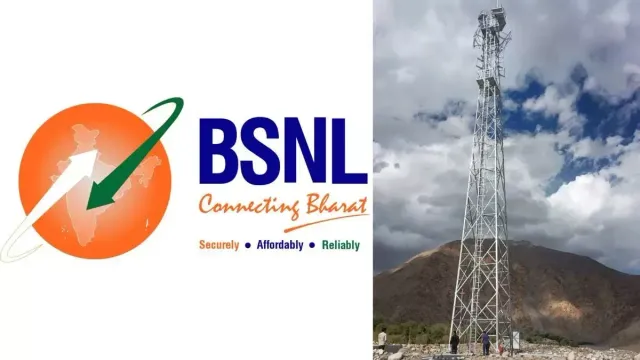- By Akansha Pandey
- Tue, 18 Nov 2025 05:37 PM (IST)
- Source:Jagran News Network
The year 2000 marked a pivotal moment in India’s telecommunications history with the establishment of Bharat Sanchar Nigam Limited (BSNL). Coincidentally, the same year saw the formation of the state of Jharkhand. Over the past two and a half decades, BSNL Jharkhand has evolved from a modest beginning into the state's communication lifeline, connecting remote villages, forests, and hilly terrains.
Umesh Prasad Sah, GM (Enterprise Business) of the Jharkhand Circle, detailed the organisation's achievements, highlighting the transition from legacy systems to modern digital infrastructure. Today, BSNL provides mobile services to 1.6 million people across the state.
Chronicle Of Growth: Infrastructure And Network Evolution
In its nascent stage, BSNL Jharkhand operated with limited resources from two floors of the GMTD Ranchi building and a rented facility named Sankalp Bhavan. In 2003, operations shifted to the ARTTC building.
2003 (The Beginning): Mobile services were launched in the state. Traffic was managed via the C-DOT MSC in Patna, operating with just 13 mobile BTS (Base Transceiver Stations).
2006 (Expansion): The network was strengthened with the integration of Ericsson technology.
2009 (3G Era): High-speed data and video calling arrived as BSNL launched 3G services in 11 major cities, including Ranchi.
2016 (4G Launch): New systems like ZTE HLR, Media Gateway, and SGSN were added, paving the way for 4G services and digital connectivity in remote areas.
Today, the network has expanded from the initial 13 BTS to approximately 6,000 mobile BTS, serving as proof of BSNL's commitment to bridging the digital divide.
Connecting The Unconnected: Focus On Rural And Naxal-Affected Areas
BSNL Jharkhand has played a critical role in penetrating the state's most difficult geographical terrains.
LWE Project (2015-16): With support from the Universal Service Obligation Fund (USOF), over 800 mobile towers were installed in inaccessible and Naxal-affected areas, providing first-time connectivity to villagers.
4G Saturation Project (2024): Realising the vision of Atmanirbhar Bharat (Self-reliant India), BSNL launched C-DOT 4G services using indigenous technology. Under this scheme, over 700 new 4G towers were installed in remote areas lacking private operator presence. Additionally, 4G services were extended to 816 LWE towers.
Data Surge: Following the 4G expansion, daily data traffic jumped from 41 TB to 68 TB in just six months.
Broadband And Optical Fibre Expansion
The circle has made significant strides in wireline and broadband connectivity through the BharatNet and FTTH initiatives.
BharatNet: Launched in 2013, physical work began in 2024 from Banda Gram Panchayat in Gola block. Over the next seven years, more than 16,000 km of Optical Fibre Cable (OFC) was laid to connect every Gram Panchayat.
FTTH Success: Fibre to the Home services, launched in 2020, have empowered hospitals, schools, and industries. By 2024, the customer base exceeded 50,000.
Strategic Assets And Enterprise Business
Enterprise Business has emerged as a core strength for the circle, providing customised digital solutions to the coal, steel, mining, and energy sectors.
Key Clients: Trusted partners include BCCL, CCL, SAIL, and various government departments.
Mining Connectivity: State-of-the-art communication facilities have been established in SAIL Bokaro Steel Plant mining areas in Gua, Kiriburu, and Meghatuburu.
Coal India Connectivity: In a historic step, BSNL signed an MoU with CMPDI in September 2025 to provide 5G CNPN services to mines across the country.
Health Sector: The circle secured an order worth Rs 117 Crore from the Jharkhand Health Department to provide Wi-Fi in hospitals, CHCs, and PHCs.
Asset Monetisation: BSNL has leased buildings to prestigious institutions like IIIT Ranchi, GST, and LIC.
ISRO Gateway: The ARTTC campus houses the Earth Stations for G-SAT11 and G-SAT 20. This facility serves as the communication backbone for Northeast India and remote mobile sites in Jharkhand.
Training: Established in 2003, ARTTC Ranchi continues to produce skilled engineers and technical experts.
Future Roadmap: 5G, 6G And Security
Looking ahead to the next 25 years, BSNL Jharkhand is preparing for a massive digital transformation.
5G and 6G: The immediate priority is the upgrade to 5G, followed by high-speed 6G facilities.
Security: Plans are in place to offer Secured CCTV Services and Secured Internet Services to mitigate hacking risks.
Sustainability: The circle is moving towards renewable energy and smart infrastructure.
In Conversation: GM-EB Umesh Prasad Sah
Q: How much has BSNL promoted the communication revolution in the state?
GM: When the Jharkhand circle started, we did not have a single BTS tower. In the last 25 years, we have installed 6,000 BTS towers. Notably, over 800 of these were installed in remote areas, building the network from the ground up.
Q: Has the connectivity problem in rural areas been resolved?
GM: The connectivity problem has been almost resolved in most rural areas of the state. For the first time, we installed 815 BTS towers in areas where Naxalism was at its peak, bringing connectivity to these regions.
Q: What is the upcoming plan?
GM: Under its upcoming action plan, BSNL has set a target to launch 5G for the public in 2026 and bring 6G to the masses by 2030.
Q: Why has there been such a delay in providing 5G services?
GM: Currently, we are providing 5G services to the corporate world, and there is no shortage of resources. However, due to technical reasons, we have lagged behind in providing 5G services to the general public. This service will be launched at an affordable price in 2026.

